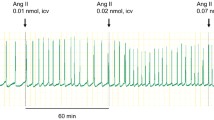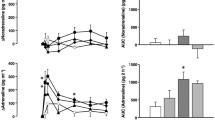Abstract
Angiotensin II, if injected into the lateral ventricles of rabbits in doses of 0.015–0.15 μg, has an inhibitory action on the fear response evoked by electrical stimulation of the ventromedial hypothalamic nucleus, but in doses of 1–10 ng it blocks the inborn behavioral fear responses in rats. On microionophoretic application of angiotensin II to single neurons in the cerebral cortex and parafascicular complex of the thalamus, predominantly activation responses were observed. Predominance of inhibitory neuronal responses were noted in structures of the hypothalamus and mesencephalic reticular formation to angiotensin II. Responses of cortical and subcortical neurons to angiotensin II are potentiated after stimulation of the “fear center” in the ventromedial hypothalamus. The hypothesis was put forward that depression of the fear response after administration of angiotensin II is connected with changes in cortico-subcortical relations, during which ascending activating influences of the mesencephalic reticular formation on the cerebral cortex are abolished due to descending influences of cortical and thalamic neurons.
Similar content being viewed by others
Literature cited
B. Anderson, “Central mechanisms of regulation of the water balance,” Third Anokhin Lectures, Moscow, January, 1982 [in Russian], Academy of Medical Sciences of the USSR, Moscow (1982), pp. 5–9.
Yu. Z. Anisimov, “Microionophoretic study of mechanisms of the central action of the natural oligopeptides angiotensin II and bradykinin,” Author's Abstract of Candidate's Dissertation, Moscow (1982).
V. I. Badikov, “Neuronal activity of the cerebral cortex under qualitatively different biological activating influences, Proceedings of the 22nd Conference on Problems in Higher Nervous Activity to Celebrate the 120th Anniversary of I. P. Pavlov's Birth [in Russian], Academy of Sciences of the USSR, Ryazan' (1969).
V. I. Badikov, A. E. Gabuniya, and E. A. Lomakina, “Effect of angiotensin II on behavioral and autonomic responses in rabbits,” Izv. Akad. Nauk Mold. SSR, No. 6, 49–52 (1982).
A. V. Val'dman, É. É. Zvartau, and M. M. Kozlovskaya, The Psychopharmacology of Emotions [in Russian], Meditsina, Moscow (1976).
O. A. Gomazkov, “Physiologically active peptides and regulation of arterial pressure under normal and pathological conditions,” Vopr. Med. Khimii,30, No. 3, 79–86 (1984).
V. G. Zilov, “Interaction between cortical and hypothalamic influences on single neurons of the mesencephalic reticular formation,” Fiziol. Zh. SSSR,55, No. 11, 1326–1333 (1969).
M. Koldits, “Participation of angiotensin II in negative emotional responses,” Zh. Vyssh. Nerv. Deyat.,35, No. 2, 280–287 (1958).
M. Koldits and E. V. Koplik, “Action of angiotensin II on neurons of the mesencephalic reticular formation of rats under conditions of acute emotional stress,” Neirokhimiya,3, No. 2, 219–220 (1984).
A. N. Kravtsov and M. Koldits, “Sensitivity of neurons of the parafascicular complex of the rabbit thalamus to angiotensin II during stimulation of the ventromedial hypothalamus,” Byull. Éksp. Biol. Med.,97, No. 2, 172–174 (1984).
I. P. Levshina, K. Gekht, M. Poppai, T. Schlegels, D. Kraints, and A. Wollenberger, “Angiotensin II as an endogenous Stressor,” Zh. Vyssh. Nerv. Deyat.,27, No. 2, 363–365 (1979).
S. P. Narikashvili, “Influence of the cerebral cortex on thalamic nuclei and brainstem reticular formation,” in: Cortical Control of Activity of Subcortical Brain Formations [in Russian], Metsniereba, Tbilisi (1968), pp. 211–241.
M. O. Samoilov, V. P. Nikitin, D. G. Semenov, V. N. Maiorov, and V. V. Sherstnev, “Response of identified neurons of mollusks to some regulators of metabolism at different levels of oxygen supply,” Byull. Éksp. Biol. Med.,92, No. 9, 266–269 (1981).
K. V. Sudakov, V. V. Sherstnev, and S. A. Osipovskii, “Direct action of angiotensin II on central neurons,” Byull Éksp. Biol. Med.,82, No. 7, 899–902 (1976).
V. V. Sherstnev and V. I. Badikov, “Investigation of the role of angiotensin II in the formation of central mechanisms of emotionally motivated states,” in: Mechanisms of Activity of Brain Systems [in Russian], Academy of Medical Sciences of the USSR, Gor'kii (1978), p. 153–155.
E. A. Yumatov and E. V. Bykova, “The role of angiotensin II in central neurochemical reactions during negative emotional states,” in: Problems in Physiology of the Hypothalalum [in Russian], No. 17, Vysshaya Shkola, Kiev (1983), p. 8–13.
Yu. Z. Anisimov (J. Z. Anissimov), J. I. Deleva, N. A. Nicolov, K. V. Sudakov, and V. V. Sherstnev, “neuronal sensitivity of some brain regions to angiotensin 2 in rabbits,” Agressology,21, No. 3, 171–175 (1980).
D. Baranowska, J. J. Braszko and K. Wisniewski, “Effect of angiotensin 2 and vasopressin on acquisition and extinction of conditioned avoidance in rats,” Psychopharmacology,81, No. 3, 247–251 (1983).
M. C. Boadle-Biber, “Increase in the activity of tryptophan hydroxylase from slices of rat brainstem incubated with angiotensin 2,” Biochem. Pharm.,28, No. 21, 3243–3246 (1979).
J. Braszko and K. Wisniewski, “Effect of angiotensin on the central action of dopamine,” Pol. J. Pharmacol. Pharm.,28, No. 6, 667–672 (1976).
D. G. Changaris, W. B. Severs and L. C. Keil, “Localization of angiotensin in rat brain,” J. Histochem. Cytochem.,26, No. 7, 593–607 (1978).
D. Felix, P. Schelling, and H. L. Haas, “Angiotensin and single neurons,” in: Exp. Brain Res. Suppl.4, The Renin Angiotensin System in the Brain, ed. by D. Ganten, M. Printz, M. I. Phillips, and B. A. Scholkens, Springer-Verlag, Berlin (1982), pp. 255–269.
C. Fischer-Ferraro, V. E. Nahmod, D. J. Goldstein and S. Finkielman, “Angiotensin and renin in rat and dog brain,” J. Exp. Med.,133, No. 2, 353–361 (1971).
J. T. Fitzimons, “Angiotensin stimulation of the central nervous system,” in: Reviews of Physiology, Biochemistry, and Pharmacology, Vol. 87, Springer-Verlag Berlin (1980), pp. 117–167.
K. Fuxe, D. Ganten, T. Hokfelt and P. Bolme, “Immunohistochemical evidence for the existence of angiotensin 2 containing nerve terminals in the brain and spinal cord of the rat,” Neurosci. Lett.,2, 229–234 (1976).
K. Fuxe, K. Andersson, D. Ganten, T. Hokfelt and P. Eneroth, “Evidence for the existence of angiotensin 2-like immunoreactive central neuronal system and its interaction with the central catecholamine pathways,” in: Enzymatic Release of Vasoactive Peptides, ed. by F. Gross and H. G. Vogel, Raven Press, New York (1980), pp. 161–170.
D. Ganten, H. T. Ungar, and R. E. Lang, “The tissue renin-angiotensin systems: focus on brain angiotensin, adrenal gland and arterial wall,” Clinical and Experimental Hypertension, Theory and Practice, No. 8, 1099–1118 (1983).
J. Haulica, G. Petresu, A. Stratone, D. Branisteanu, V. Rosce, C. Neamtu, and S. Slatineanu, “Possible functions of brain renin,” Exp. Brain Res., Suppl. 4, 335–352 (1982).
W. R. Hess, “Hypothalamus und Thalamus, Exper. Documents,” Beitrage zum Physiologie des Hirnstammes, Vol. 3, Stuttgart (1956).
R. W. Hunsperger and V. M. Bucher, “Affective behavior produced by electrical stimulation in the forebrain and brainstem of the cat,” in: Progr. Brain Res. (Amsterdam)27, 103–127 (1967).
R. A. Nicoli and J. L. Barker, “Excitation of supraoptic neurosecretory cells by angiotensin 2,” Nature New Biol.,233, No. 40, 172–174 (1971).
N. A. Nicolov, K. V. Sudakov, J. I. Deleva, V. I. Badikov, V. V. Sherstnev, and E. A. Yumatov, “Effect of angiotensin and bradykinin on neurons of the sensomotor cortex,” Exp. Brain Res., Suppl. 4, 270–283 (1982).
M. Phillips, “Angiotensin in the brain, “ Neuroendocrinology,25, No. 6, 354–377 (1978).
M. I. Phillips, J. Weyhenmeyer, D. Felix, D. Ganten and W. E. Hoffman, “Evidence for an endogenous brain renin-angiotensin system,” Federat. Proc.,38, No. 9, 2260–2266 (1979).
D. Regoli, W. W. Park, and F. Rioux, “Pharmacology of angiotensin,” Pharmacol. Rev.,26, No. 2, 69–123 (1974).
I. A. Reid and D. S. Ramsay, “The effects of intracerebroventricular administration of renin on drinking and blood pressure,” Endocrinology,97, No. 3, 536–542 (1975).
B. A. Scholkens, W. Jung, W. Raseher, T. Ungar and D. Ganten, “Cardiovascular and humoral effects of endogenous brain angiotensin,” in: Exp. Brain Res., Suppl. 4, The Renin Angiotensin System of the Brain, ed. by D. Ganten, M. Pritz, M. I. Phillips, and B. A. Scholkens, Springer-Verlag Berlin (1982), pp. 297–310.
W. B. Severs and A. E. Daniels-Severs, “Effects of angiotensin on the central nervous system,” Pharm. Rev.,25, No. 3, 415–449 (1973).
G. Simonnet, M. F. Giorguieff-Chesselet, A. Carayon, B. Bionlac, F. Cesselion, J. Glowinsky and J. D. Vincent, “Angiotensin II et systeme nigro-neostriatal,” J. Physiol. (Paris),77, No. 1, 71–79 (1931).
T. Suga, M. Suzuki and M. Suzuki, “Effects of angiotensin II on the medullary neurons and their sensitivity to acetylcholine and catecholamines,” Jap. J. Pharm.,29, No. 4, 541–552 (1979).
J. G. Summy-Long, L. C. Keil, K. Deen, L. Rosella and W. B. Severs, “Endogenous opioid peptide inhibition of the central actions of angiotensin,” J. Pharmacol. Exp. Ther.,217, No. 3, 619–629 (1981).
C. Sumners, M. I. Phillips, “Central injection of angiotensin II after catecholamine activity in rat brain,” Am. J. Phys.,244, No. 2, 257–263 (1983).
J. M. Wayner, T. Ono and D. Nolley, “Effects of angiotensin II on central neurons,” Pharma. Biochem. Behav.,1, 679–691 (1973).
Author information
Authors and Affiliations
Additional information
Translated from Fiziologicheskii Zhurnal SSSR imeni I. M. Sechenova, Vol. 72, No. 6, pp. 713–722, June, 1986.
Rights and permissions
About this article
Cite this article
Sudakov, K.V. Angiotensin II as a factor inhibiting the fear response. Neurosci Behav Physiol 17, 74–83 (1987). https://doi.org/10.1007/BF01186811
Received:
Issue Date:
DOI: https://doi.org/10.1007/BF01186811




